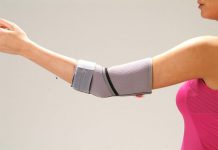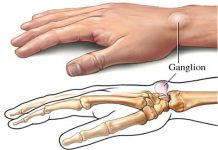WHAT IS GANGLION CYST?
Ganglion is the most commonly seen mass on the hand and the wrist. These masses are not maling (cancer) and do not spread to other tissues and organs. Ganglion is a fluid-filled swelling with a pedicle (figure 1) Inside fluid material is gelly or jelly. Its formation reasonis not clearly known. It is assumed that it is formed as a reaction to the constraining of the joints or tendons. Indeed, it is most commonly seen on the dorsum of the wrist joint (figure 2). The palmar area of the wirst and joint edge of the fingertips are the secondary common parts (figure 3 and figure 4). Ganglion cysts may change in size in time. It might get bigger,smaller or completely disappear. It might recur with the constrain of the joint after it completely disappears.
HOW TO DIAGNOSE?
The location of the mass and the clinical Picture is generally sufficient to establih a diagnose. Ganglion cysts may be either painfull or painless. The cysts on the hand dorsum are round and oval shaped and partially soft. The cysts on the fingertips and palm are approximately pea-sized, painfulll and highly stiff. Sometimes these can be considered as a bony tissue by the patient.
Even it is controversiory that radiography is requested for every patient, it enables not to pass any additional pathologies. The most commonly observed additional pathology is the spur formed as a result of arthritis on the joint adjacent to the mass.
WHAT IS THE TREATMENT?
Generally, the treatment does not require surgical intervention. If the patient has pain, medication and splint called tools can be used to keep the joint stable another treatment method is the aspiration of the mass with an injector. Recurrence of the mass (filling with liquid) is highly probable after this method. If the mass is painless, observation and follow-up is sufficient. In case the pain is not relieved, causes limitation of movement in the joint adjacent to the mass or cosmetically disturbs the patient (figure 5) surgical treatment can be preferred. If the mass is on the wrist joint, it can be removed by open or artroscopic method (video). If it is on the other areas, open surgery is the only option. The success rate after duly performed surgical treatment is around 90%. During the surgery, by carefully preserving the surrounding tissues the mass and the capsule of the adjacent joint is removed (figure 6-7).
WHAT IS THE PROCESS OF SURGICAL TREATMENT, WHAT IS AHEAD OF US?
x-Ray graphy may be required after the consultation with the Orthopedician or Hand Surgeon. In most of the cases, daycase (short stay at the hospital) hospitalization is preferred. There is no need to apply general anesthesia. Generally, it is sufficient to make local (axiallry block or RIVA) anesthesia. If the mass is on the wrist joint, it can be removed by open or artrosopic method. For the other areas, open surgery is the only option. During your consultation with your doctor, it is very important to mention about your special conditions (chronic diseases, regularly taken medication etc.). ın the early period after the surgery (postop 3 days), cold application and keeping your hand above the heart level will reileve the pain and throbbing. In the post op early period, your wrist will be covered by a bandage or a splint. The wound is controlled by opening the bandage between 5-7 days. If there is no complication, you can take shower. Even rarely, you might need physical therapy and rehabilitation after this period. Even though the general progress canges in accordance with the surgery performed and the condition of your wrist, you are generally expected to go bak your normal life within 3 weeks.
PROBABLE COMPLICATIONS
The most important complication is the recurence of the mass after the surgery; however this probablity is highly low. There is a risk of stiffness and limitation of movement after the surgery especially on the wrist joint. The secondary complications are hemotoma on the surgical wound, infection, limitation of finger movement due to the tissue adhesion on the surgically treated area, chronic pain (RSD having late or not having the expected results.












